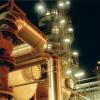Hi all,
I've got a vessel with the following pressure rating - (-64/+64mbarg).
There is a desire to clean this vessel with hot water via a sprayball as hot water has proven to be more effective at cleaning the material we process (non-flammable formulation work).
My concern in reagrds to utlising hot water for this system is specifically the inbreathing rate associated with vapour collapse - hot water cleaning suddenly changing to cold i.e. 60oC saturated vapour space converting to 10oC saturated space.
Info: 10m3 vessel -64/+64mbarg
Hot water: 60oC
Cold water: 10oC
Sprayball: 7.2m3/h total flow
Relief stream: 4" swan neck - 2300m3/h relief capacity
Calculating the relief volume is relatively straightforward but the rate is hard to quantify. Is it 1 second? 5 seconds? 10 seconds? 6.5 seconds is the maximum rate that this relief stream could handle under these conditions.
Is there any guidance / good practise in regards to these operations? Do i do an enery balance approach i.e. entalpy balance to work to relate time vs temp assuming instant equilibrium conditions?
Or is good practise to avoid hot cip cleaning of atmospheric vessels in general to eliminate the risk and accept the poorer cleaning efficiency - water usage/waste incineration/time etc?
Any advice is much appreciated.
Andrew

 FB
FB












